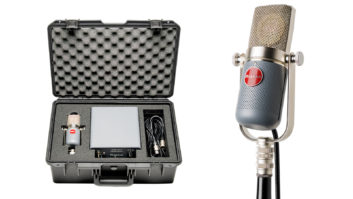Designed and manufactured in Australia, RODE microphones have earned an enviable position among recording professionals. The company’s Classic, NTV, NT1 and NT2 models can be found in leading studios worldwide, and with the recent introduction of the new Classic II, RODE could once again be on the road to repeating its earlier successes.
The RODE Classic II is a tube condenser mic developed from its popular original Classic model. In developing the Classic II, RODE’s goal was to elevate the mic to the next level, while retaining the character of its predecessor.
Everything about the Classic II points to the fact that it is a high-end recording tool. The microphone ships in an industrial-strength, foam-lined aluminum flight case, which houses the various system components. In addition to the microphone, the package includes a dedicated power supply, a 30-foot, double-shielded, oxygen-free multicore cable with custom-tooled military-grade gold-plated connectors, a stand-mount adapter, and a shockmount suspension.
Weighing in at just over two pounds, the Classic II is a heavy, magnificently crafted instrument. The microphone’s body is machine-tooled from solid brass and encapsulates two grille meshes-a finely woven inner headscreen and a heavier gauge, outer screen. A gold dot indicates the front of the microphone. The combination of a new capsule and further refinements to the microphone’s electronic circuitry are the principal factors that distinguish the Classic II from the original.
The Classic II features a 1-inch dual-pressure gradient capsule with an edge-terminated, gold-sputtered diaphragm. Further, the microphone incorporates a low-noise, 6072 twin-triode tube preamplifier that feeds into a custom Jensen output transformer. There are no controls on the microphone, yet the Classic II provides a wealth of options for securing your desired sound.
The Classic II has both -10dB and -20dB pads, along with a two-position highpass filter-both of which are remotely switched from the microphone’s power supply. The highpass filter offers -15 or -21 dB of roll-off at 20 Hz. Similarly, there are nine polar patterns that range from omni with the control in the counterclockwise position to cardioid at the midpoint to figure-8 pattern when turned fully clockwise.
Specs include a stated frequency response of 20 to 20k Hz, with a sensitivity rating of 13mV/Pa. Maximum SPL handling is 130 dB, noise is less than 22 dB and impedance is 250 ohms.
Instrument SetupLike the microphone, the Classic II’s external power supply is solidly built and comes factory-set for 120V current in North America. The unit can also be set for 220-240V operation. A ground lift switch is provided should you encounter a ground loop hum.
A multicore 12-pin cable connects the mic and its power supply by aligning a series of notches on the connectors. A white dot is also provided for visual assistance. All connectors are gold-plated to ensure optimum signal quality. Audio output is routed via a standard XLR connector on the rear panel of the power supply.
After powering the unit on, you need to allow several minutes for the microphone to warm up and stabilize. The power supply’s LED drive circuit feeds off the filament voltage of the tube, becoming brighter as the instrument approaches optimum operating level, thus providing visual indication that the Classic II is ready for use.
In SessionWith nine polar patterns to choose from, the Classic II provides considerable timbral variation. Overall, the instrument’s frequency response is generally flat, but as is typical for a figure-8 pattern, high-end performance appears slightly diminished when placed into this mode. For vocal recording, the cardioid pattern exhibits a mild boost in the mid to upper midrange-a quality that does wonders for delivering presence to the human voice. In omni mode, the mic exhibited roughly a 6dB bump at around 10 kHz. With a variety of intermediate positions between these three main polar patterns, combined with the two-position highpass filter and the -10dB and -20dB pads, this microphone provides ample opportunity to find the right sound for numerous recording applications.
I used the Classic II on a number of vocal and instrumental recordings. I recorded a series of dialog tracks, vocal tracks, solo flute and acoustic guitar. I also miked a Fender Stratocaster played through a Yamaha guitar amp.
For both close-proximity dialog work and the recording of vocal performances, the Classic II was absolutely terrific. For dialog, I used the cardioid pattern with the talent placed roughly 7 to 8 inches from the mic with a sheer nylon pop filter placed between. The Classic rewarded me with big, detailed and full-sounding takes that were “ready to go.” Using a pop filter to help reduce the occurrence of high-level plosives is recommended: The same material without the pop filter exhibited quite a bit more plosive sounds and sibilance, which would have required more effort after the fact to fix.
Vocal performances were met with equal success, exhibiting a warm, natural texture with a rich lower end. The microphone’s off-axis response is exemplary, delivering even-sounding performances even as the vocalist moved somewhat in order to hit the high notes and generate the vocal inflections we were looking to capture.
This was similarly the case with the flautist. The Classic II delivered a very even, full-sounding tone, yet with an open, “airy” quality that made the instrument sound extremely musical-even with a fair amount of movement from the player.
The Classic II delivered exceptional results with acoustic guitar. The instrument was recorded on a hardwood floor with the mic placed just far enough away to capture both direct and reflected sound. The Classic II picked up a detailed composite sound where finger movement, room ambience, harmonics and fundamental tones all blended together with astonishing accuracy.
For a tube mic, I found the Classic II’s self-noise to be low. While the Classic II wouldn’t be my first choice for critical classical recordings, it’s not likely to be an issue for any other application.
On electric guitar, the Classic II delivered its best performance when it was placed roughly 18 inches and slightly off-axis from the speaker enclosure. This mic is very sensitive, and with the high sound pressure levels generated by the cabinet, the -10dB and -20dB pad settings were called into service to more effectively manage signal levels. The Classic II sounded really big, with loads of detail and an awesome sheen to the overall sound.
ConclusionThe Classic II’s ability to capture all the nuances of a performance makes it an outstanding choice for instrumental and vocal recording. Its off-axis response is excellent-delivering uniform, consistent sound quality-and its ability to handle relatively high sound-pressure levels makes it that much more versatile.
The RODE Classic II has a world-class look and feel and comes with first-class accessories-all packaged in a beautiful flight case that could probably withstand a Volvo driving over it. With nine polar patterns, two pad settings and its two-position highpass filter, it has the flexibility to tailor the instrument to deliver the sound that best suits your needs. Further, the microphone’s $1,995 price tag strikes me as quite modest. Bottom line: The RODE Classic II is a full-featured microphone with a big, full sound that delivers stellar results.
RODE, distributed in North America by Event Electronics, P.O. Box 4189, Santa Barbara, CA 93140-4189; 805/566-7777; fax 805/566-7771; www.event1.com.







